The Feed Mixer market is experiencing substantial growth driven by the increasing demand for efficient and precise feed management solutions in the livestock and poultry sectors. The future outlook for this market is influenced by the rising focus on optimizing feed quality, reducing wastage, and improving livestock productivity. Technological advancements in mixer design and automation have enabled precise formulation and uniform mixing, which is critical for maintaining animal health and maximizing output.
Additionally, the adoption of advanced feed mixers is supported by the expansion of commercial farming operations and rising awareness regarding nutritional requirements across different livestock types. Increasing investments in modern farming infrastructure and the need to comply with regulatory standards related to feed quality are further propelling market growth.
The market is also benefiting from the rising demand for portable and scalable feed mixers that can be integrated into existing farm operations As the global livestock industry grows and mechanization becomes more widespread, feed mixers are expected to remain a critical component in improving operational efficiency and sustainability.
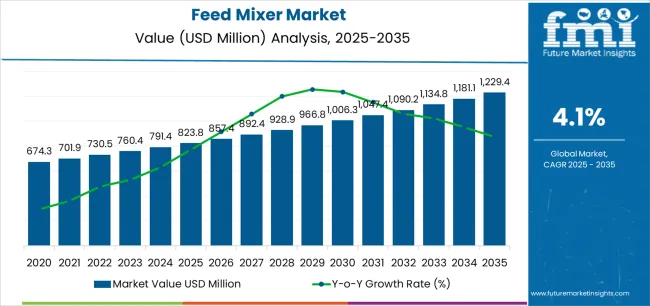
| Metric | Value |
|---|---|
| Feed Mixer Market Estimated Value in (2025 E) | USD 823.8 million |
| Feed Mixer Market Forecast Value in (2035 F) | USD 1229.4 million |
| Forecast CAGR (2025 to 2035) | 4.1% |
The market is segmented by Product Type, Portability, Capacity, and Application and region. By Product Type, the market is divided into Vertical and Horizontal. In terms of Portability, the market is classified into Self-Propelled, Pull, and Stationary. Based on Capacity, the market is segmented into 10 To 20 ^3 M, <10 ^3 M, and >20 ^3 M. By Application, the market is divided into Farms and Feed Factory. Regionally, the market is classified into North America, Latin America, Western Europe, Eastern Europe, Balkan & Baltic Countries, Russia & Belarus, Central Asia, East Asia, South Asia & Pacific, and the Middle East & Africa.
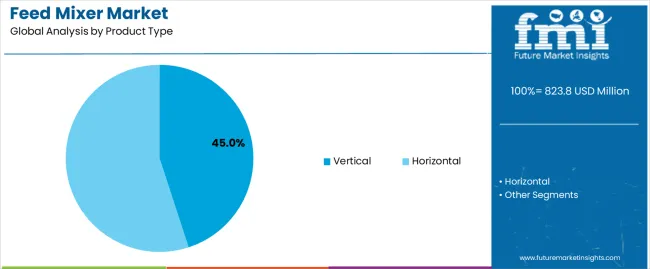
The vertical product type segment is projected to hold 45.0% of the Feed Mixer market revenue share in 2025, making it the leading product type. This growth is primarily driven by the superior mixing efficiency and uniformity offered by vertical mixers, which ensures consistent feed quality.
Vertical mixers are highly preferred for their ability to handle diverse feed ingredients and maintain nutrient balance, which is essential for livestock health. The segment has been supported by ongoing enhancements in mixer design, including automated features and energy-efficient operations.
Additionally, vertical mixers are adaptable to both small and large-scale farming setups, which has increased their adoption across commercial and semi-commercial operations The durability, reliability, and low maintenance requirements of vertical mixers have further reinforced their position as a preferred choice in feed preparation, ensuring continued growth in this segment.
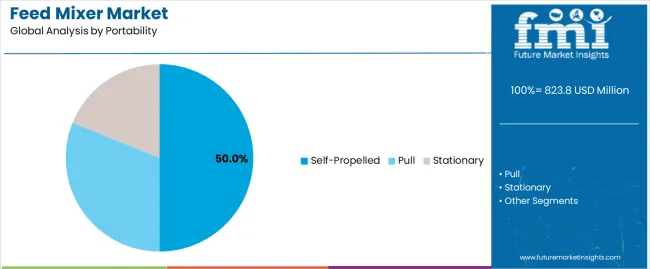
The self-propelled segment is expected to capture 50.0% of the Feed Mixer market revenue share in 2025, establishing it as the leading portability type. This segment has been driven by the convenience and flexibility provided by self-propelled mixers, which allow feed to be transported and distributed efficiently across large farms.
The ability to operate independently without external towing or transportation equipment enhances operational productivity and reduces labor costs. Self-propelled mixers are increasingly preferred in commercial farming operations where time-efficient and accurate feed delivery is critical.
Additionally, technological advancements in mobility, automation, and user-friendly control systems have further accelerated the adoption of self-propelled feed mixers The growing emphasis on reducing feed wastage and optimizing farm management practices has reinforced the dominance of this segment in the market.
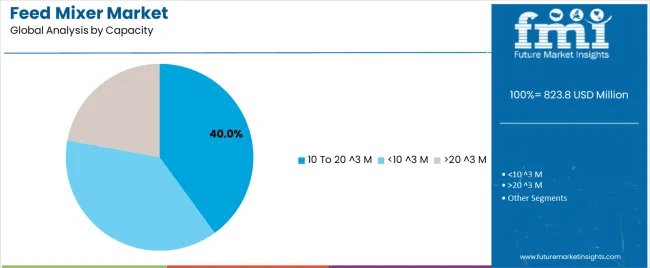
The 10 to 20 m3 capacity segment is anticipated to account for 40.0% of the Feed Mixer market revenue in 2025, making it the leading capacity range. This growth is attributed to the optimal balance it offers between operational efficiency and flexibility, catering to medium to large-scale commercial farms.
Mixers in this capacity range allow precise handling of substantial feed volumes while maintaining uniform mixing quality, which is essential for livestock nutrition. The segment has benefited from improvements in motor efficiency, structural durability, and user-friendly control systems, which enhance productivity and reduce downtime.
Additionally, 10 to 20 m3 capacity mixers are versatile enough to support diverse feed formulations and can be integrated into both manual and automated farm operations The combination of scalability, efficiency, and reliability has reinforced the adoption of this capacity segment, ensuring its leading position in the market.
Thriving Livestock Sector Creating Growth Prospects for Feed Mixers
The livestock sector is experiencing rapid growth globally due to exploding population and surging demand for dairy, meat, and other livestock products. This, in turn, is creating a high need for efficient feed mixing solutions to ensure better nutrition and growth of livestock.
More and more people are consuming animal proteins to stay fit and healthy. According to the OECD-FAO Agricultural Outlook, global meat protein consumption is estimated to grow 14% by 2035. To meet this demand, farms will need to raise more animals, which necessitates using more efficient feed practices and feed mixing tools.
Farmers are also focusing on improving the health and well-being of their animals. This will further propel feed mixer demand as they ensure consistent, balanced meals, leading to healthier animals.
High Adoption of Innovative Feeding Equipment
Farm mechanization continues to penetrate its roots, especially across nations like India and China. This is anticipated to positively impact the global feed mixer industry during the assessment period.
More and more farms and feed factories are installing advanced feed mixing solutions like automatic ones to enhance productivity and reduce costs. These technologies also allow end users to manage larger herds and meet their feed requirements.
Rise of Precision Animal Nutrition
The growing popularity of precision livestock farming, as well as precision animal nutrition, is setting a new platform for the feed mixing equipment market growth. These novel approaches create a strong demand for efficient feed mixing solutions to allow the proper amount of feed with a suitable composition to be supplied to animals in a timely manner.
Feed mixing equipment is becoming key to precision nutrition, allowing animals to get customized feed mixes that meet their exact requirements. They ensure a homogenous mixture of various feed ingredients, maximizing nutrient intake and reducing waste.
With more and more farmers showing interest in precision feeding, adoption of feed mixing solutions is bound to grow significantly. This will play a key role in boosting market growth during the assessment period.
The section comprehensively evaluates three interrelated markets: the global feed mixing equipment industry, the vibratory feeder machine market, and the animal feed processing equipment industry. It dissects each market's distinctive characteristics, encompassing their respective CAGRs, while delving into the pivotal factors influencing their growth trajectories.
Global Feed Mixer Market Analysis:
| Attribute | Global Feed Mixer Market Analysis |
|---|---|
| CAGR (2025 to 2035) | 4.3% |
| Growth Factors | Surging demand for high-quality animal feed is a key factor boosting market growth. |
| Key Trends in Feed Mixer Market | Jey growth shaping trends include the growing interest in precision feeding and ongoing innovation and technological advancements in feed mixers. |
Global Vibratory Feeder Machine Market Forecast:
| Attribute | Global Vibratory Feeder Machine Market Forecast |
|---|---|
| CAGR (2025 to 2035) | 4.3% |
| Growth Factor | Increasing adoption of vibratory feeder machines across diverse industries is boosting market growth. |
| Key Trends | High penetration of automation is a key trend influencing market growth. |
Global Animal Feed Processing Equipment Industry Analysis:
| Attribute | Global Animal Feed Processing Equipment Industry Analysis |
|---|---|
| CAGR (2025 to 2035) | 4.2% |
| Growth Factor | Increasing livestock production and surging demand for high-quality feed are key factors fueling market growth. |
| Key Trends | Key growth influencing trends include surging popularity of automation and robotics and increasing interest in precision feeding. |
The table below shows the projected growth rates of the top countries. South Korea and Japan are forecast to record high CAGRs of 6.5% and 5.9%, respectively, through 2035.
| Countries | CAGR (2025 to 2035) |
|---|---|
| United States | 4.6% |
| United Kingdom | 5.6% |
| China | 4.9% |
| Japan | 5.9% |
| South Korea | 6.5% |
The table below highlights key countries’ market revenues. The United States and China are set to remain the top consumers of feed mixing machines, with predicted valuations of USD 1229.4 million and USD 188.9 million, respectively, in 2035.
| Countries | Market Revenue (2035) |
|---|---|
| United States | USD 1229.4 million |
| United Kingdom | USD 49.1 million |
| China | USD 188.9 million |
| Japan | USD 133.8 million |
| South Korea | USD 78.2 million |
The latest trends predict the United States to remain a key consumer of feed mixing machines, accumulating a total revenue of USD 1229.4 million by 2035. Demand in the nation is set to surge at 4.6% CAGR throughout the forecast period.
Several factors are anticipated to propel growth of the market in the United States. These include growing focus on animal health, increasing importance of precision feeding, and high adoption of automated feeding systems to enhance farm productivity.
American farmers have become aware of the importance of animal health for both economic and ethical reasons. As a result, they are widely using advanced feeding systems, including mixers, to ensure that animals receive a consistent and properly mixed diet.
Feed mixing machines have the ability to create a homogenous feed mix, thereby helping farmers provide high-quality, balanced feed to their livestock. Thus, as the awareness regarding animal feed nutrition grows, so will demand for feed mixers.
Escalating demand for animal products, especially meat, in the United States is acting as a catalyst triggering market growth. Meat to Americans is more popular than Taylor Swift and Elvis Presley put together, and there is no end in sight for the meat industry.
According to the United States Department of Agriculture (USDA), the United States had access to 224.6 pounds of poultry and red meat in 2025. Further, beef consumption per capita in the nation reached around 58.8 pounds in 2025. This leads to an increased demand for efficient feed mixing equipment to ensure optimal nutrition and growth of livestock.
The livestock industry in China is witnessing robust growth fueled by surging demand for animal products and a rise in meat exports. To meet this demand, animal and dairy farms are increasingly adopting efficient and reliable feed mixing solutions, thereby boosting sales growth.
As per Future Market Insights’ latest report, sales of feed mixers in China are estimated to grow at 4.9% CAGR during the forecast period. By 2035, China's market size is predicted to reach USD 188.9 million.
End users in China are also inclined towards using advanced feed mixing tools, such as self-propelled models. High adoption of these advanced mixers in the feed mixing process for greater precision, efficiency, and automation will boost market growth.
The Chinese government is also supporting the country’s feed production sector by encouraging the development and adoption of advanced feed mixing technologies. This will bode well for China’s feed mixing machine market.
The section below offers key insights into leading segments and their respective shares and growth rates. This information can be useful for companies to invest in popular products.
By product type, vertical mixer segment dominates the market and is poised to grow at 4.1% CAGR through 2035. Based on capacity, the 10 to 20 ^3 M category will record a CAGR of 3.8% from 2025 to 2035.
| Top Segment | Vertical (Product Type) |
|---|---|
| CAGR (2025 to 2035) | 4.1% |
As per the latest report, vertical mixer segment dominated the global industry with a share of 65% in 2025. Over the next ten years, demand for vertical mixers is projected to surge at 4.1% CAGR. This can be attributed to their advantages, like versatility and cost-effectiveness.
Vertical mixers have become workhorses in the agricultural landscape. They are widely used in small farms due to their lower cost, smaller footprint, simple design, and other benefits. This will continue to boost segment growth through 2035.
From small trailer-mounted options to large ones, vertical mixers come in various sizes to suit different farming operations. These mixers are more energy-efficient and require less space, which is improving their popularity.
Surging popularity of vertical mixers, especially across space-constrained environments like small farms or feed factors, will continue to fuel their demand through 2035. On the other hand, horizontal mixers are set to witness significant demand amid their adoption across large farms or factors.
| Top Segment | 10 to 20 ^3 M (Capacity) |
|---|---|
| CAGR (2025 to 2035) | 3.8% |
Based on capacity, 10 to 20 ^3 M segment leads the market with a share of 44.0% in 2025. Further, a CAGR of 3.8% has been assigned for the same segment by Future Market Insights’ analysts between 2025 and 2035.
High adoption of mixer machines across medium-sized farms seeking a balance between efficiency and affordability is boosting segment growth. Similarly, growing trend of precision framing will benefit the target segment.
Mid-sized mixers (10 to 20 ^3 M) offer a unique combination of efficiency and practicality for farms. These mixers help farmers improve mixing time and feed quality without investing in much larger mixers.
10 to 20 ^3 M mixers are perfect for implementing TMR (total mixed ratio) feeding systems, ensuring precise nutrient delivery to livestock. Thus, surging demand for consistent, high-quality feed due to automation and big data in agriculture will further boost segment growth.
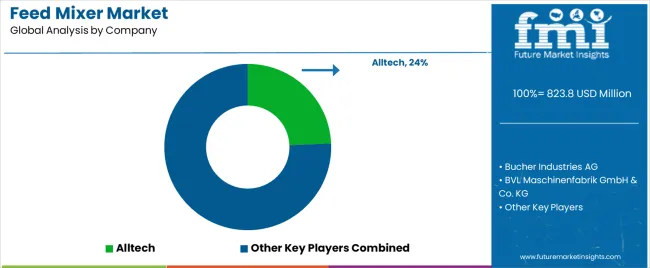
The global market is becoming competitive due to high presence of regional and domestic players. It offers lucrative opportunities, prompting manufacturers of mixers to invest in product innovation strategies.
Top players are constantly launching new feed mixing equipment to cater to different farm sizes. They are incorporating advanced technologies like precision weighing mechanisms and automated loading/unloading systems in their products to enhance their functionality and efficiency.
Several players are also looking to reduce feed mixing equipment prices to address the initial investment barrier for smaller farms. Similarly, strategies like partnerships, distribution agreements, exhibitions, and acquisitions are becoming popular as companies look to strengthen their presence.
Recent Developments
| Date and Approach | Description |
|---|---|
| March 2025, New Product Launch | Sweden-based DeLaval introduced DeLaval Optimat, a new autonomous feeding solution that provides everything from weighing, cutting, and mixing to delivering the feed to the feed table. |
| October 2025, New Product Launch | Italy-based FARESIN Industries launched a new self-propelled electric mixer for animal husbandry. |
| New Product Launch | Recently, Switzerland-based Bucher Industries showcased its new agricultural equipment, including an autonomous feed mixer. |
The global feed mixer market is estimated to be valued at USD 823.8 million in 2025.
The market size for the feed mixer market is projected to reach USD 1,229.4 million by 2035.
The feed mixer market is expected to grow at a 4.1% CAGR between 2025 and 2035.
The key product types in feed mixer market are vertical and horizontal.
In terms of portability, self-propelled segment to command 50.0% share in the feed mixer market in 2025.






Full Research Suite comprises of:
Market outlook & trends analysis
Interviews & case studies
Strategic recommendations
Vendor profiles & capabilities analysis
5-year forecasts
8 regions and 60+ country-level data splits
Market segment data splits
12 months of continuous data updates
DELIVERED AS:
PDF EXCEL ONLINE
Feed Mixer for Livestock Market Size and Share Forecast Outlook 2025 to 2035
Self-loading Feed Mixer Market Growth – Trends & Forecast 2024-2034
Feed Preparation Machine Market Size and Share Forecast Outlook 2025 to 2035
Feed Additive Nosiheptide Premix Market Size and Share Forecast Outlook 2025 to 2035
Feeder Container Market Size and Share Forecast Outlook 2025 to 2035
Feed Machine Market Forecast Outlook 2025 to 2035
Feed Pigment Market Forecast and Outlook 2025 to 2035
Feed Grade Spray-dried Animal Plasma (SDAP) Market Size and Share Forecast Outlook 2025 to 2035
Feed Electrolytes Market Size and Share Forecast Outlook 2025 to 2035
Feed Micronutrients Market Size and Share Forecast Outlook 2025 to 2035
Feed Acidifier Market Analysis Size Share and Forecast Outlook 2025 to 2035
Feed Flavors Market Size and Share Forecast Outlook 2025 to 2035
Feed Enzymes Market Analysis - Size, Share, and Forecast Outlook 2025 to 2035
Feed Mycotoxin Binders Market Size and Share Forecast Outlook 2025 to 2035
Feed Phytogenics Market Size and Share Forecast Outlook 2025 to 2035
Feed Carbohydrase Market Size and Share Forecast Outlook 2025 to 2035
Feed Grade Oils Market Analysis - Size, Share, and Forecast Outlook 2025 to 2035
Feed Packaging Market Size, Share & Forecast 2025 to 2035
Feed Mycotoxin Detoxifiers Market Analysis - Size, Share, and Forecast Outlook 2025 to 2035
Feed Premix Market Analysis - Size, Share, & Forecast Outlook 2025 to 2035

Thank you!
You will receive an email from our Business Development Manager. Please be sure to check your SPAM/JUNK folder too.
Chat With
MaRIA